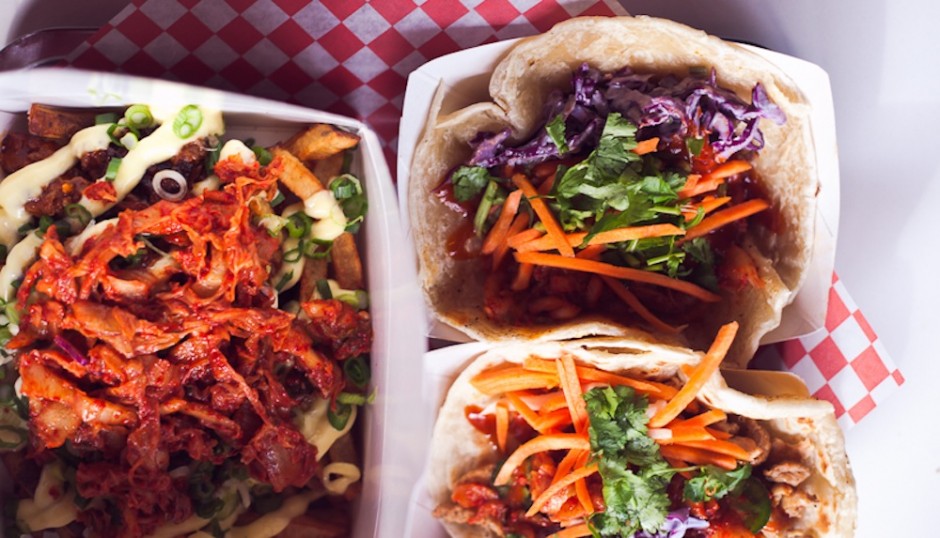Earlier this year, blogTO published a list called “The top 10 most outrageous fusion meals in Toronto.” This list included “novel mash-ups” such as the bulgogi cheesesteak (from Oddseoul) and the cheeseburger spring roll (from Lee). By describing these meals as the “trend du jour,” the article suggests that the entire concept of fusion — or food that combines techniques and styles from two or more cuisines — is a gimmick. But fusion is not merely a passing food fad to be forgotten when the next big trend hits the city.
 Fusion is hardly a new idea and certainly not something Toronto can proudly call its own. According to Nick Liu, the former executive chef of Niagara Street Café and the upcoming GwaiLo, fusion entered the culinary mainstream in the ‘90s. These fusion dishes looked a lot like “miso in smoked salmon and wrapping it in Vietnamese rice paper,” says Liu.
Fusion is hardly a new idea and certainly not something Toronto can proudly call its own. According to Nick Liu, the former executive chef of Niagara Street Café and the upcoming GwaiLo, fusion entered the culinary mainstream in the ‘90s. These fusion dishes looked a lot like “miso in smoked salmon and wrapping it in Vietnamese rice paper,” says Liu.
He adds, “These dishes were usually created by French-trained chefs, chefs not of these cultures. This type of cuisine lacked culture and history and was a trend that died back in the ‘90s.”
The type of “fusion” found in restaurants today tends to have different roots, both historically and culturally. Ask any Toronto foodie about what comes to mind when they think of “fusion,” and they would be quick to drop a few well-known names: the Lee Family, Susur Lee and his sons, Kai and Levi Bent-Lee; and the Han brothers. Leeto and Leemo, owners of Swish by Han and Oddseoul are just a few of the many.
This particular group consists of young chefs who are primarily of Asian heritage. Trying to stay true to what is commonly defined as “Chinese” or “Japanese” food is complicated in a city as diverse as Toronto. For many of these chefs, rather than resisting the influences of these other cultures and trying to stay within the boundaries of “Chinese” food, they welcome external influences. The result is a new style of cuisine that is both innovative and delicious.

Liu describes his style of cooking as a “natural integration” of the Asian dishes he grew up with and his own personal belief in using locally sourced food. But don’t you dare call his food “fusion” — in fact, the term is dreaded among the new crop of chefs who are creating dishes that food critics and media would label as such.
Liu instead prefers “new Asian cuisine,” or simply “Canadian.” Many would be quick to point out that Toronto is the furthest thing from a homogenous city. Our neighbourhoods are a reflection of the ethnicities that were once the largest in the city: Chinatown, Little India, and Greektown, for starters. While it is easy to identify certain dishes associated with certain ethnicities, trying to define “Canadian” food is problematic.
Although Shinji Yamaguchi — owner of Gushi, a street stall that specializes in a style of Japanese street food called kushikatsu — grew up in Japan, it is pretty clear that the Gushi menu was strongly influenced by his experience in “Canadian” dining. One notable item is Gushi poutine — a hybrid of the Canadian staple and Gushi’s signature chicken.
 The history behind the poutine meal at Gushi is simple: Yamaguchi wanted to combine both of his favourite foods into one meal. Many of us consider the act of starting off the day with a double-double and doughnut from Tim Hortons as a way of asserting our Canadian identity, but we seldom think about why we consider this combination to be “Canadian.” Perhaps the reason why there has been so much obsession with “fusion” food is its tendency to take dishes we consider “traditional” and reimagine them as a dish that is culturally indistinct.
The history behind the poutine meal at Gushi is simple: Yamaguchi wanted to combine both of his favourite foods into one meal. Many of us consider the act of starting off the day with a double-double and doughnut from Tim Hortons as a way of asserting our Canadian identity, but we seldom think about why we consider this combination to be “Canadian.” Perhaps the reason why there has been so much obsession with “fusion” food is its tendency to take dishes we consider “traditional” and reimagine them as a dish that is culturally indistinct.
These new hybrid cuisines aren’t killing off cultures; they are celebrating them in new ways. Innovators are bringing the mingling of cultures on the streets of Toronto and other cities into the kitchen and forging new courses within traditional cuisines.
Fusion food — debates about the authenticity of bulgogi cheesesteaks and kimchi fries aside — asks diners to consider the diversity of personal histories and influences behind a single dish. Much more than a trend for foodies to cash in on, fusion is a natural and exciting product of what happens when a chef of another ethnicity grows up in Canada.

Comments
One response to “The way we eat now”
http://nicoletastestoronto.wordpress.com/2013/11/07/lunchbanh-mi-boys/ wooh shameless promotion